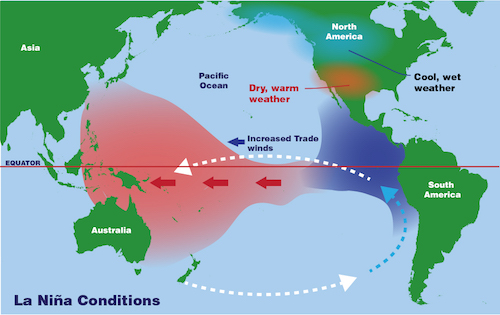La Niña: A Thorough Study
Understanding its causes, mechanics, and global impacts.
What is La Niña?
La Niña, meaning "The Little Girl" in Spanish, is the cold phase of the El Niño-Southern Oscillation (ENSO) cycle, characterized by cooler-than-average sea surface temperatures (SST) in the equatorial Pacific Ocean.
- Key Features:
- Decline in SSTs in the eastern Pacific.
- Abnormal pressure patterns.
- Typically lasts 9 months to 3 years.

Figure 1: Visual representation of La Niña's oceanic patterns.
Mechanics of La Niña
The mechanics of La Niña involve intensified trade winds and cold water upwelling near South America.
- Enhanced Trade Winds: Push warm surface waters westward, forming a warm pool near Asia and Australia.
- Upwelling: Cold, nutrient-rich waters rise to the surface near South America.
- Walker Circulation: Strengthened atmospheric circulation pattern.

Figure 2: Comparison between El Niño and La Niña weather patterns.
Global Impact of La Niña
La Niña significantly impacts global weather, agriculture, and fisheries:
- Weather: Floods in Australia, droughts in South America, and snowier winters in North America.
- Agriculture: Strong monsoons in India and drought-affected crops in South America.
- Fisheries: Boosted fish populations due to nutrient-rich waters.
La Niña and India
In India, La Niña is closely associated with enhanced monsoon rainfall and colder winters.
- Above-average monsoon rainfall benefits agriculture but may cause floods.
- Colder winters due to deeper penetration of Siberian air masses.
Historical La Niña Events
- 2010–2011: Queensland floods in Australia, drought in East Africa.
- 1999–2000: Drought in the southern US, floods in Mozambique.
- 2017–2018: Moderate La Niña with wetter Southeast Asia and drier southern Africa.
How is La Niña Monitored?
Scientists monitor La Niña using a variety of tools:
- Oceanic Niño Index (ONI): Tracks SST anomalies in the Pacific.
- Buoys and Satellites: Measure real-time oceanic and atmospheric data.
- Climate Models: Simulate ENSO dynamics and predict impacts.
Conclusion
La Niña is a natural phenomenon with far-reaching impacts. Understanding its mechanics and consequences is crucial for effective risk management and leveraging opportunities in agriculture, fisheries, and disaster response.

Good Information 👍, More details needed...
ReplyDelete